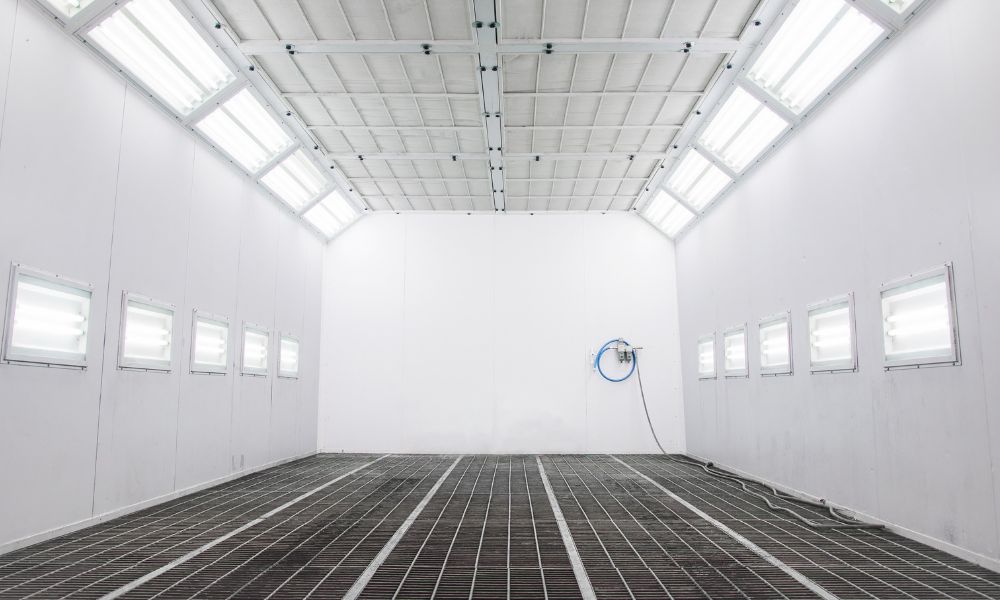
Can Your Existing Industrial Paint Booth Meet Modern Safety Standards?
- admin11
- 0
- on Apr 14, 2025
Paint booths might look the same over the years, but what’s going on inside them can quietly become outdated. New safety standards roll out often, and older booths may not keep up—especially when they’ve been running non-stop for years. Whether it’s fire safety, airflow, or lighting, there’s more happening behind the panels than most shop owners realize.
Identifying Obsolete Fire Suppression Risks in Your Current Booth
Fire suppression systems in industrial paint booths aren’t meant to last forever. Technology evolves, chemicals change, and what used to pass inspections a decade ago might now be flagged as unsafe. Some booths still rely on older suppression setups that aren’t fast or sensitive enough for today’s materials. If the sensors don’t detect a flash fire instantly, the delay can be the difference between a minor incident and a major loss.
Updated booths use advanced fire detection and quick-response suppression agents that meet current codes. These systems react to high heat and smoke far faster than older models. Also, local safety codes often change without much warning, which means a booth that passed last year might not meet today’s minimums. Checking your current system against updated NFPA and OSHA guidelines helps keep both your crew and equipment safer in the long run.
Hidden Hazards of Non-Compliant Airflow Systems in Industrial Booths
Airflow is one of the most important safety features in any industrial paint booth—but also one of the easiest to overlook. If the air doesn’t move correctly, flammable vapors can build up fast. Booths designed years ago may not have the right airflow speed or direction, which increases the risk of fire or explosion. Sometimes, fans wear out or get coated in overspray, which reduces their performance without anyone noticing.
Even the layout matters. Booths should have balanced airflow that moves fumes away from the operator and exhausts them properly. A failing or out-of-spec airflow system can also suck in dust and debris, contaminating finishes and endangering workers. Inspecting the booth’s intake filters, fan performance, and airflow direction isn’t just maintenance—it’s a vital checkup that protects people and property.
Recognizing Outdated Filtration That Compromises Worker Health
Filtration systems trap particles and fumes before they can affect workers or get released into the air. In older booths, filters may no longer be efficient enough to catch modern solvent fumes or fine overspray. If workers regularly experience headaches, dizziness, or respiratory issues, the booth’s filtration setup might not be doing its job. And worn-out filters can clog airflow, making the booth unsafe in multiple ways.
Modern industrial paint booths use multi-stage filtration, with pre-filters, primary filters, and sometimes final-stage HEPA filters for ultra-clean exhaust. These not only protect the finish but also keep harmful particulates out of the workspace. Checking filter specs, replacement intervals, and sealing around the filter frame can uncover weaknesses that aren’t obvious at first glance.
Evaluating Paint Booth Lighting Standards for Enhanced Safety Compliance
Lighting inside a paint booth isn’t just about seeing what you’re doing—it’s a safety measure. Dim or uneven lighting makes it easier to miss mistakes, or worse, spill flammable materials in the wrong place. Older booths often use outdated fluorescent fixtures that flicker, fade, or aren’t explosion-proof. If the light quality isn’t consistent, the risk of both poor finishes and accidents goes up.
Newer industrial paint booths come with LED lighting systems that are brighter, longer-lasting, and built for hazardous locations. These lights also produce less heat and use less energy. Evaluating your current lighting against today’s safety codes includes checking for:
● Proper light placement across all work zones
● Fixture seals to prevent vapor intrusion
● Heat levels around flammable areas
If your booth lighting hasn’t been upgraded in over five years, it’s probably falling short of current standards.
Risks Associated with Aging Exhaust and Ventilation Mechanisms
Ventilation keeps the booth clear of flammable fumes and maintains the airflow that keeps overspray in check. But as exhaust fans and ducts age, their ability to move air properly drops. Rust, worn motors, or bent ducting can choke the system and create pressure issues that make the booth unsafe. This isn’t just a performance problem—it’s a serious fire hazard.
When evaluating an older industrial paint booth, pay attention to how fast it clears after spraying. If fumes linger or pressure seems unbalanced, something in the exhaust path may be failing. A well-functioning ventilation system:
● Maintains steady airflow velocity
● Meets local exhaust air quality rules
● Removes overspray efficiently without pushing it into other areas
Spotting these issues early can prevent shutdowns or compliance fines.
Understanding Structural Deficiencies That Fail Modern OSHA Regulations
Booth walls, doors, and seals aren’t just there to hold the structure together—they also help contain hazardous materials and maintain proper airflow. Over time, seams may loosen, panels warp, or insulation degrade. These changes may not be visible from the outside, but they can throw the whole system off. If doors don’t seal tight or walls rattle under pressure, your booth might not meet modern OSHA expectations.
OSHA looks at the full structure of a booth, from the strength of its frame to how well it contains combustible materials. Inspectors often flag aging panels, gaps in joints, or missing insulation as violations. Keeping up means ensuring your industrial paint booth structure is tight, clean, and secure. Replacing or reinforcing parts before they fail saves more than money—it keeps your workers protected and your operations running smoothly.